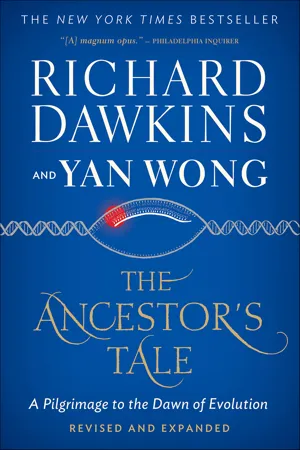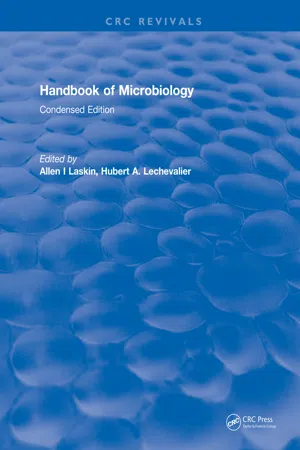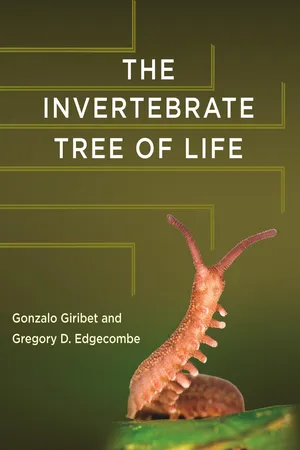Choanoflagellates
Choanoflagellates are a group of free-living unicellular organisms that are considered to be the closest living relatives of animals. They are characterized by a distinctive collar of microvilli surrounding a single flagellum, which they use for movement and feeding. Choanoflagellates play a significant role in understanding the evolutionary origins of multicellular animals.
6 Key excerpts on "Choanoflagellates"
- eBook - ePub
Organelles, Genomes and Eukaryote Phylogeny
An Evolutionary Synthesis in the Age of Genomics
- Robert P Hirt, David S. Horner(Authors)
- 2004(Publication Date)
- CRC Press(Publisher)
...Within this protist phylum, four classes are recognized: Choanoflagellatea, Ichthyosporea, Corallochytrea and Cristidiscoidae (Cavalier-Smith, 1998b). 5.4.1 Choanoflagellatea Choanoflagellates are single-celled heterotrophic uniflagellates that inhabit marine and freshwater systems and feed on bacteria. Morphological features that distinguish them from other protists include the presence of a single posteriorly directed flagellum in the motile stage, a collar of filter-feeding microvilli and the presence of siliceous (lorica) or organic (theca) structures that envelope the cell (Sleigh, 1989; Buck, 1990; Hausmann and Hülsmann, 1996). Despite the Choanoflagellates being a highly distinct taxon, there has been considerable disagreement on their classification. For example, they have also been classified in the phylum Choanoflagellata, Kingdom Mastigota (Hausmann and Hülsmann, 1996) and as eukaryotes without known sister taxa (Patterson, 1999). All classifications recognize three families: Codonosigidae (e.g., Sphaeroeca), Salpingoecidae (e.g., Salpingoeca) and Acanthoecidae (e.g., Diaphanoeca) (Buck, 1990; Hausmann and Hülsmann, 1996). The Acanthoecidae differs from the other two in that the basket-like loricae of its members are composed of silica. At some stage of their life cycles, most Salpingoecidae Choanoflagellates have thecas composed of organic compounds such as chitin, whereas Codonosigidae cells are sometimes embedded in mucilaginous matrices. A number of Choanoflagellates are solitary (e.g., Monosiga), whereas others live in colonial systems (e.g., Codonocladium) (Hausmann and Hülsmann, 1996). The Choanoflagellates are famous for the possibly pivotal position they hold in the ancestry of animals and fungi, and they share similarities with both the basal animals and the fungi (Cavalier-Smith, 1987, 1998b; Wainright et al., 1993)...
- eBook - ePub
The Ancestor's Tale
A Pilgrimage to the Dawn of Evolution
- Richard Dawkins, Yan Wong(Authors)
- 2016(Publication Date)
- Mariner Books(Publisher)
...Rendezvous 32 Choanoflagellates The Choanoflagellates are the first protozoans to join our pilgrimage, and they do so at Rendezvous 32 which, with worrying uncertainty, we place at 800 million years ago, at the youngest end of most molecular clock estimates. Look at the picture below. Do the little flagellated cells remind you of anything? Yes, they are very similar to the choanocytes lining the water canals of sponges. It has long been suspected that either they represent a hangover from a common ancestor, or Choanoflagellates are the evolutionary descendants of sponges that have degenerated to single cells or very few cells. Molecular genetic evidence suggests the former, which is why I am considering them as separate pilgrims, joining our pilgrimage here. There are about 140 species of Choanoflagellates. Some are free-swimming, propelling themselves along with the flagellum. Others are attached by a stalk, sometimes several together in a colony, as in the picture. They use their flagellum to drive water into the funnel, where food particles such as bacteria are trapped and engulfed. In this respect they are different from the choanocytes of sponges. In a sponge, each flagellum is used not to drive food into the individual funnel of the choanocyte, but in co-operation with other choanocytes to draw a current of water in through holes in the walls of the sponge and out through the sponge’s main opening. But anatomically each individual choanoflagellate, whether it is in a colony or not, is suspiciously similar to a sponge choanocyte...
- eBook - ePub
Thorp and Covich's Freshwater Invertebrates
Ecology and General Biology
- James H. Thorp, D. Christopher Rogers(Authors)
- 2014(Publication Date)
- Academic Press(Publisher)
...Some anaerobic flagellates have hydrogenosomes, the anaerobic derivatives of mitochondria. Almost all of these are endosymbionts or internal parasites of animals. They are also known as parabasalians and include many of medical or economic importance, e.g., the human parasite Trichomonas vaginalis, and Trichomitopsis, which degrades cellulose in the hindgut of termites and other wood-eating insects and also supports endosymbiotic methane-producing bacteria (termites may be responsible for a globally significant flux of methane to the atmosphere) (Fenchel and Finlay, 1995). Most Choanoflagellates are small (<10 μm), with a feeding filter that forms a “collar” around the single anterior flagellum (Figures 7.1 and 7.3). The flagellum creates the water current that flows through the filter. Choanoflagellates are exclusively phagotrophic and either solitary (e.g., Monosiga) or colonial (e.g., Sphaeroeca). They are important grazers of the smallest suspended bacteria in fresh waters and in the marine plankton (e.g., Salpingoeca, Stephanoeca, and Parvicorbicula). FIGURE 7.3 A selection from the variety of form and function in flagellated protozoa. (a) A choanoflagellate with bacterial food trapped on the external surface of the collar filter (Monosiga ; body + collar 0.015 mm). (b) A bacteria-feeding helioflagellate (Pteridomonas ; body ∼0.007 mm). (c) A phagotrophic euglenid (Dinema ; ∼0.03 mm) with an ingested diatom. (d) A marine heterotrophic dinoflagellate (Protoperidinium ; ∼0.06 mm) with a diatom trapped in its feeding veil. (e) A free-living, bacteria-feeding, anaerobic diplomonad (Hexamita ; body ∼0.008 mm). (f) A small heterotrophic (bacteria-feeding) cryptomonad flagellate (Goniomonas ; ∼0.008 mm). (g) A heterotrophic, typically bacteria-feeding, chrysomonad flagellate (Spumella : body ∼0.008 mm). (h) A bacteria-feeding bodonid (Rhynchomonas ; body ∼0.005 mm). Euglenids usually have two flagella that emerge from a small anterior pocket...
- eBook - ePub
Handbook of Microbiology
Condensed Edition
- Allen I Laskin(Author)
- 2019(Publication Date)
- CRC Press(Publisher)
...Various Volvox species are under scrutiny because they secrete diffusible factors eliciting differentiation of sexual colonies. 37 Order Prasinophyceae Mainly marine planktonic, these organisms are not yet assimilated into the protozoological taxonomic scheme. They comprise forms previously included in the Volvocida (Chlorophyceae) or Chrysophyceae (Chrysomonadida), having scales or hairs on the surface of the flagella. Prominent genera are Pryamimonas, Nephroselmis, Platymonas, and Micromonas (one flagellum, one mitochondrion, and one chloroplast — macromorphologically the simplest known flagellate). Class 2. Zoomastigophorea (Animal-Like Flagellates) Chromatophores are absent. The organisms have one to many flagella; additional organelles may be present in mastigonts; ameboid forms, with or without flagella, are found in this class. Sexuality is known in a few groups. Many are parasitic. Order 1. Choanoflagellida A single anterior flagellum is surrounded posteriorly by a delicate collar. Some species are loricate. Attached forms may be with or without peduncle. Solitary and colonial exist. The organisms are free-living and fairly common, especially in inshore waters. Their resemblance to sponge choanocytes elicits speculation as to their being forebears of sponges. Few laboratory studies have been made; no cultures are available. Order 2. Bicosoecida Members of this group have two flagella, one free, the other attaching the posterior end of the organism to shell. The organisms are free-living. They are common, but seldom abundant, especially in fresh water. No laboratory studies have been made. Order3.Rhizomastigida Pseudopodia and one to four flagella (many in one family) are present simultaneously or at different times in trophozoites. Most species are free-living...
- eBook - ePub
- Gonzalo Giribet, Gregory D. Edgecombe(Authors)
- 2020(Publication Date)
- Princeton University Press(Publisher)
...Only one scenario, that of sponge paraphyly at the base of the animal tree, would provide the necessary power to say something about such an ancestor, as proposed by Nielsen (2008) in his “choanoblastaea” hypothesis. Sponge paraphyly is, however, disfavored in most recent phylogenetic analyses of sponges and metazoans. Two facts are important for this book. First is the position of Metazoa in the broader tree of life within a clade of Opisthokonta named Holozoa. Holozoa includes, in addition to animals, Choanoflagellates, filastereans and ichthyosporideans. Metazoa is well supported in all molecular phylogenetic analyses as sister group of Choanoflagellatea (e.g., Torruella et al., 2015) [ fig. 1.1 ]. The resemblance of Choanoflagellates to sponge choanocytes is striking and has been used a synapomorphy for the clade containing Choanoflagellates and metazoans (= Choanozoa), reinforced in those topologies that suggest sponge paraphyly at the base of animals (Nielsen, 2012a). However, few real comparisons have been made between Choanoflagellates and choanocytes until recently (Mah et al., 2014), and these authors indicated that although these cells are similar in some aspects, they differ in others, concluding that homology cannot be taken for granted. Similarities in collar-flagellum systems separated by 600 million years of evolution, whether homologous or convergent, suggest that these form important adaptations for optimizing fluid flow at microscale levels (Mah et al., 2014). Irrespective of whether or not these two cell types are homologous, animal biologists have much to learn from animals’ closest relatives. The first choanoflagellate genome, for the unicellular species Monosiga brevicollis, was thus sequenced to better understand the transition to multicellularity and tissue integration in metazoans...
- eBook - ePub
How the Earth Turned Green
A Brief 3.8-Billion-Year History of Plants
- Joseph E. Armstrong(Author)
- 2014(Publication Date)
- University of Chicago Press(Publisher)
...The chromalveolate clade is composed of the alveolates (al-VEE-oh-latts) and stramenopiles (strah-MEN-oh-piles). Alveolates are mostly motile, unicellular organisms and include many core members of the former Kingdom Protista like the ciliates (e.g., Paramecium); dinoflagellates, many of which are photosynthetic; and apicomplexans (ah-pea-com-PLEX-ans). The last group are parasitic flagellates that can form a nonmotile resting stage, a group formerly called sporozoans (spore-oh-ZOH-ans), which includes Plasmodium (plaz-MOH-deeuhm), the organism which causes malaria. The name alveolate refers to alveoli (al-VEE-oh-lye), membranous sacs located around the periphery of the cells, a novel shared feature, although no one as yet knows their function. Stramenopiles include the brown algae and a bunch of other algaland fungal-like organisms: diatoms, golden algae, yellow-green algae, water molds, slime net amoebas (labyrinthulids [lah-BRIN-thoo-lids]), and a number of other unicellular photosynthetic organisms. The biflagellate motile cells in this clade are asymmetrical, having two flagella inserted in a sub-apical to lateral position (see Appendix: Phytoplankton, stramenopile). The two flagella differ in form with one flagellum long and hairy, and the other shorter and smooth (Fig. A50). The flagellar hairs are tubular and three-parted, and the name stramenopile is derived from this shared, novel feature. Before the fungal-like water molds and amoeboid labyrinthulids were included, the group was basically algal and called Kingdom Chromista or the heterokont (“different flagella”) algae. Two groups of unique unicellular “algae,” for lack of a better term, the cryptophytes and haptophytes, are sister groups to the stramenopiles...





